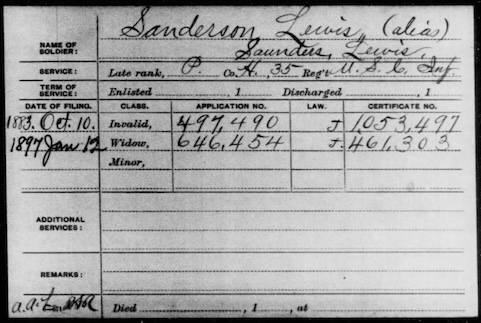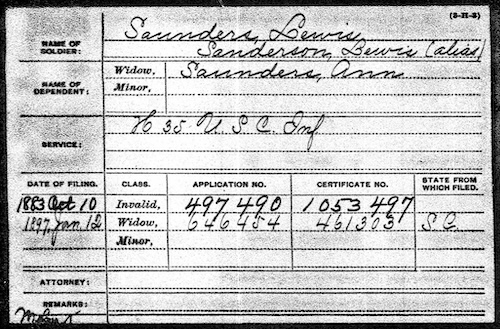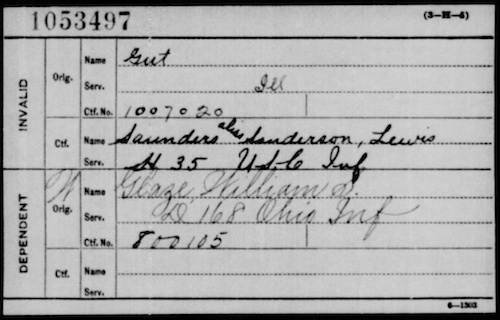
War of 1812

Gulf War

Revolutionary War

WWI
T288 - General Index to Pension Files
The T288 index encompasses pension applications filed by veterans or their dependents. While the majority pertain to Civil War service, the index also includes records from later military engagements such as the Spanish-American War, the Philippine Insurrection, and the Boxer Rebellion. It’s important to note that Confederate service members are not represented in this index, as the federal government did not provide pensions for Confederate service. It is accessible on Fold3 (with images) and FamilySearch (without images).
The soldier (veteran) submitted an application for a pension based on eligibility criteria permitted under the law at the time of filing, which could include:
- ➡️ Loss of a limb, eye, or other body part
- ➡️ Disability resulting from wounds sustained during service
- ➡️ Disability caused by disease contracted while in service
- ➡️ Advanced age, provided the veteran lived long enough to qualify

- ➡️ Civil War (1861–1865) – Union Army and Navy
- ➡️ Indian Wars (1860s–1890s)
- ➡️ Spanish-American War (1898)
- ➡️ Philippine Insurrection (1899–1902)
- ➡️ Boxer Rebellion (1900–1901)
- ➡️ World War I (1917–1918) – very limited (only those filed before 1934)
- Who’s Listed:
- ➡️ Veterans
- ➡️ Widows
- ➡️ Minor children
- ➡️ Dependent parents
- ➡️ Format: Alphabetical by veteran’s name

T289 - Organization Index to Pension Files
This index is arranged alphabetically by the name of the veteran or claimant. It provides a quick reference to pension applications filed between 1861 and 1934 and includes information such as the soldier’s unit, rank, application and certificate numbers, and the state from which the application was submitted.
- ➡️ Always note the distinction between the application number (first step) and the certificate number (if the pension was approved).
- ➡️ If the pension was not granted, there may be only an application number with no certificate number.
- ➡️ These numbers are essential for ordering the full pension file from the National Archives.
T289 - Veterans Who Served 1861 - 1900 and Wars Covered:

- ➡️ Primarily the Civil War (1861–1865)
- ➡️ Also includes some Indian Wars
- Who’s Listed:
- ➡️ Mostly Union Army veterans (grouped by unit and state)
- ➡️ Format: Alphabetical by state, then by regiment and company, then by veteran’s name
A1158 Numerical Index
Pension file A1158, also known as the Numerical Index to Pensions, 1860–1934, is a lesser-known but important cross-reference tool used by researchers trying to locate military pension files at the National Archives. Below is a comprehensive explanation of what it is, what it contains, and how it is used:
The A1158 microfilm publication, titled Numerical Index to Pensions, 1860–1934, serves as a numerical index to U.S. federal pension files. Unlike the T288 and T289 indexes, which are organized alphabetically by name or by military unit, A1158 is arranged by application and certificate numbers. This index is particularly useful when you have a pension number but lack the associated name or unit information.
A1158 is especially beneficial when cross-referencing or verifying pension information found in T288 or T289, particularly in cases where the application or certificate numbers are difficult to read or interpret. It can also help identify multiple pension files associated with a single individual, such as separate files for a veteran and their widow.

- ➡️ Format: Organized numerically by pension application and certificate numbers
- ➡️ Purpose: Facilitates locating pension files when only the application or certificate number is known
- Wars and Conflicts Covered:
- ➡️ Civil War (1861–1865)
- ➡️ Indian Wars (1860s–1890s)
- ➡️ Spanish-American War (1898)
- ➡️ Philippine Insurrection (1899–1902)
- ➡️ Boxer Rebellion (1900–1901)
- ➡️ World War I (1917–1918) – limited to applications filed before 1934


